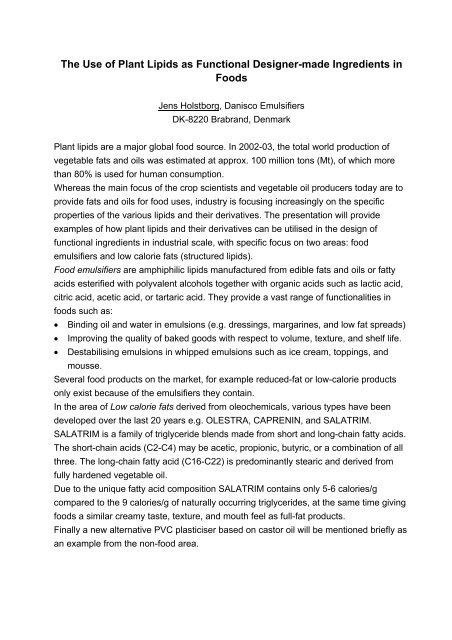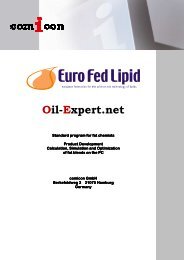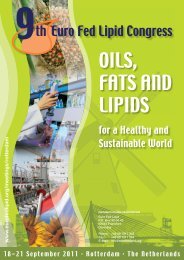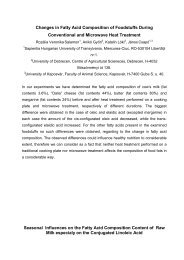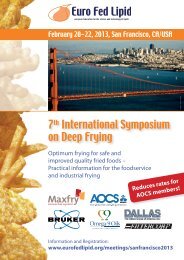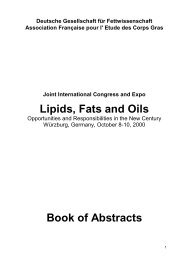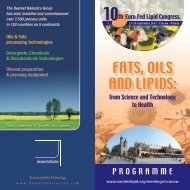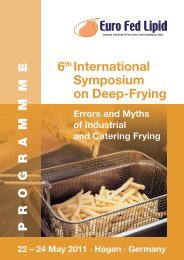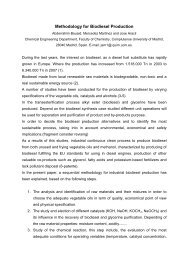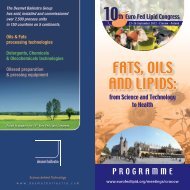Abstracts now available online - Euro Fed Lipid
Abstracts now available online - Euro Fed Lipid
Abstracts now available online - Euro Fed Lipid
You also want an ePaper? Increase the reach of your titles
YUMPU automatically turns print PDFs into web optimized ePapers that Google loves.
The Use of Plant <strong>Lipid</strong>s as Functional Designer-made Ingredients in<br />
Foods<br />
Jens Holstborg, Danisco Emulsifiers<br />
DK-8220 Brabrand, Denmark<br />
Plant lipids are a major global food source. In 2002-03, the total world production of<br />
vegetable fats and oils was estimated at approx. 100 million tons (Mt), of which more<br />
than 80% is used for human consumption.<br />
Whereas the main focus of the crop scientists and vegetable oil producers today are to<br />
provide fats and oils for food uses, industry is focusing increasingly on the specific<br />
properties of the various lipids and their derivatives. The presentation will provide<br />
examples of how plant lipids and their derivatives can be utilised in the design of<br />
functional ingredients in industrial scale, with specific focus on two areas: food<br />
emulsifiers and low calorie fats (structured lipids).<br />
Food emulsifiers are amphiphilic lipids manufactured from edible fats and oils or fatty<br />
acids esterified with polyvalent alcohols together with organic acids such as lactic acid,<br />
citric acid, acetic acid, or tartaric acid. They provide a vast range of functionalities in<br />
foods such as:<br />
• Binding oil and water in emulsions (e.g. dressings, margarines, and low fat spreads)<br />
• Improving the quality of baked goods with respect to volume, texture, and shelf life.<br />
• Destabilising emulsions in whipped emulsions such as ice cream, toppings, and<br />
mousse.<br />
Several food products on the market, for example reduced-fat or low-calorie products<br />
only exist because of the emulsifiers they contain.<br />
In the area of Low calorie fats derived from oleochemicals, various types have been<br />
developed over the last 20 years e.g. OLESTRA, CAPRENIN, and SALATRIM.<br />
SALATRIM is a family of triglyceride blends made from short and long-chain fatty acids.<br />
The short-chain acids (C2-C4) may be acetic, propionic, butyric, or a combination of all<br />
three. The long-chain fatty acid (C16-C22) is predominantly stearic and derived from<br />
fully hardened vegetable oil.<br />
Due to the unique fatty acid composition SALATRIM contains only 5-6 calories/g<br />
compared to the 9 calories/g of naturally occurring triglycerides, at the same time giving<br />
foods a similar creamy taste, texture, and mouth feel as full-fat products.<br />
Finally a new alternative PVC plasticiser based on castor oil will be mentioned briefly as<br />
an example from the non-food area.


